(PDF) Nervous and Endocrine Systems
VerifiedAdded on 2021/02/19
|16
|2618
|133
AI Summary
Contribute Materials
Your contribution can guide someone’s learning journey. Share your
documents today.
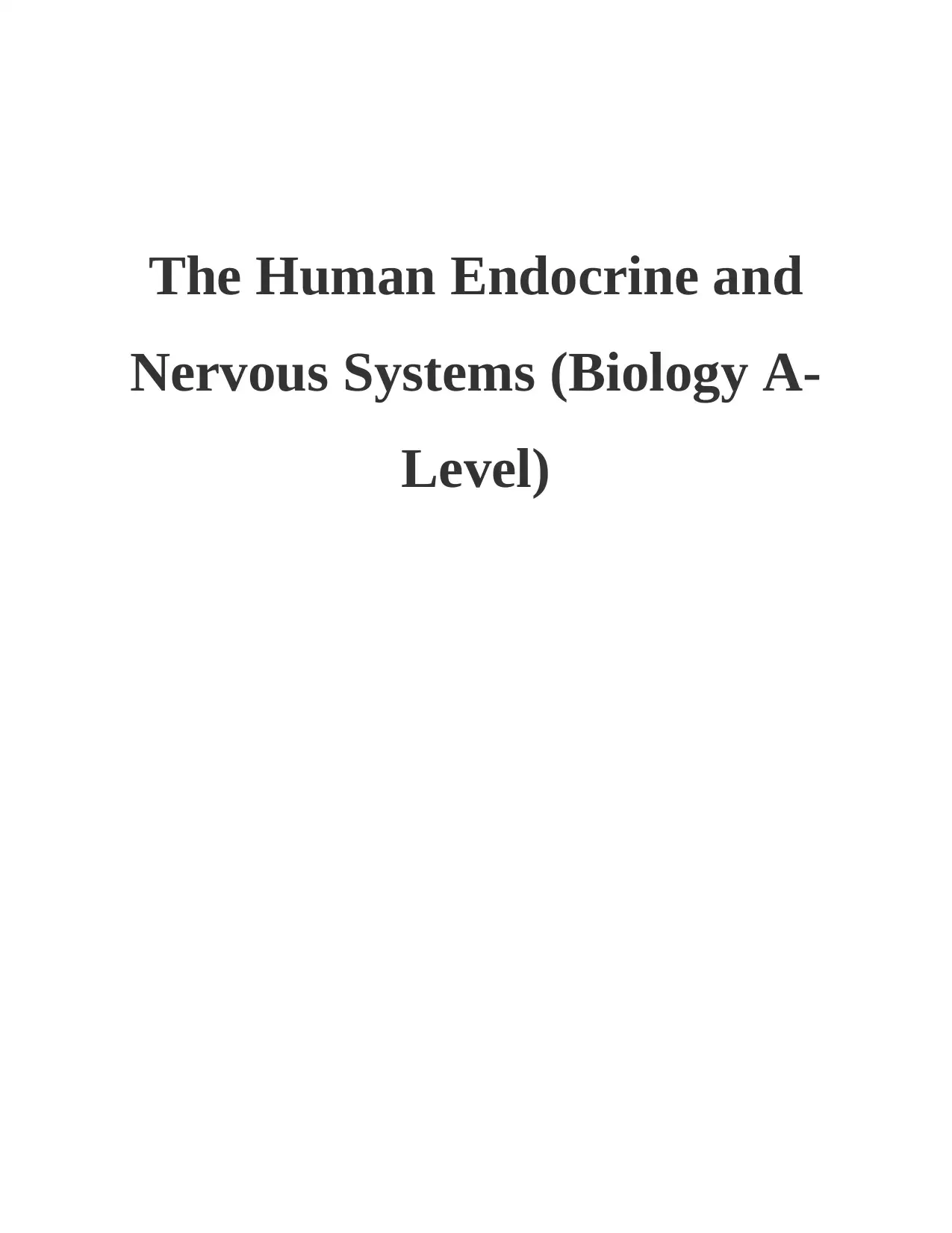
The Human Endocrine and
Nervous Systems (Biology A-
Level)
Nervous Systems (Biology A-
Level)
Secure Best Marks with AI Grader
Need help grading? Try our AI Grader for instant feedback on your assignments.
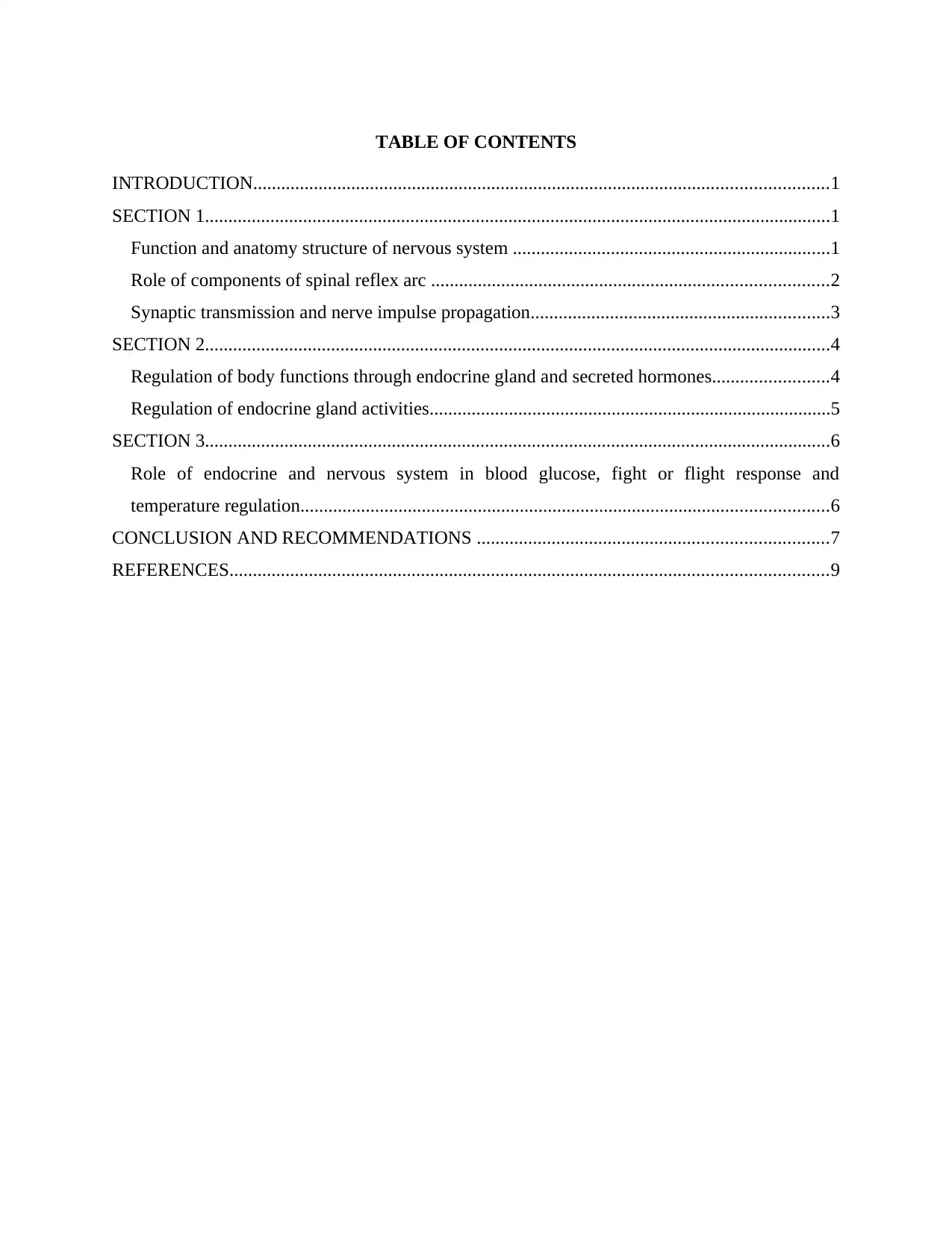
TABLE OF CONTENTS
INTRODUCTION...........................................................................................................................1
SECTION 1......................................................................................................................................1
Function and anatomy structure of nervous system ....................................................................1
Role of components of spinal reflex arc .....................................................................................2
Synaptic transmission and nerve impulse propagation................................................................3
SECTION 2......................................................................................................................................4
Regulation of body functions through endocrine gland and secreted hormones.........................4
Regulation of endocrine gland activities......................................................................................5
SECTION 3......................................................................................................................................6
Role of endocrine and nervous system in blood glucose, fight or flight response and
temperature regulation.................................................................................................................6
CONCLUSION AND RECOMMENDATIONS ...........................................................................7
REFERENCES................................................................................................................................9
INTRODUCTION...........................................................................................................................1
SECTION 1......................................................................................................................................1
Function and anatomy structure of nervous system ....................................................................1
Role of components of spinal reflex arc .....................................................................................2
Synaptic transmission and nerve impulse propagation................................................................3
SECTION 2......................................................................................................................................4
Regulation of body functions through endocrine gland and secreted hormones.........................4
Regulation of endocrine gland activities......................................................................................5
SECTION 3......................................................................................................................................6
Role of endocrine and nervous system in blood glucose, fight or flight response and
temperature regulation.................................................................................................................6
CONCLUSION AND RECOMMENDATIONS ...........................................................................7
REFERENCES................................................................................................................................9
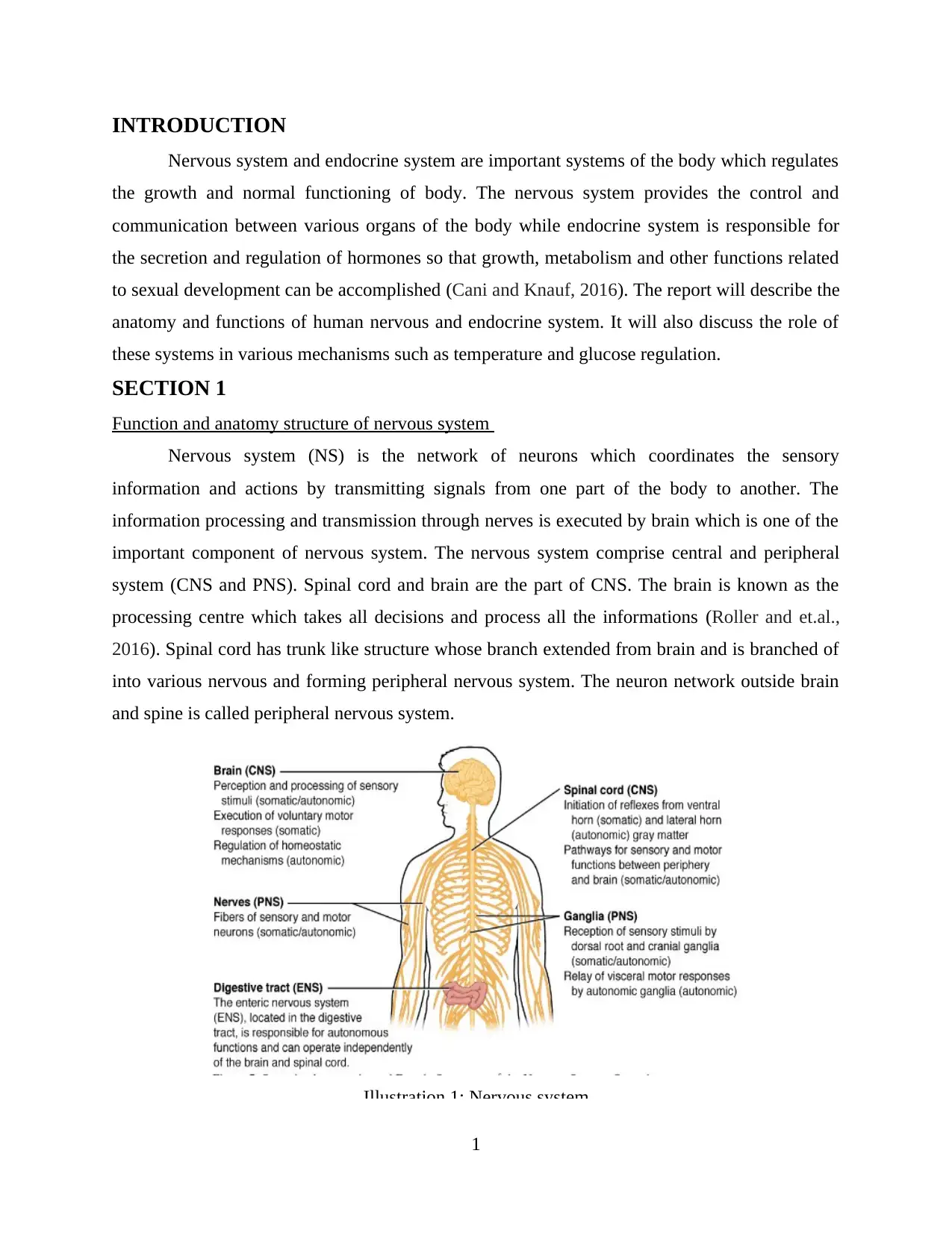
INTRODUCTION
Nervous system and endocrine system are important systems of the body which regulates
the growth and normal functioning of body. The nervous system provides the control and
communication between various organs of the body while endocrine system is responsible for
the secretion and regulation of hormones so that growth, metabolism and other functions related
to sexual development can be accomplished (Cani and Knauf, 2016). The report will describe the
anatomy and functions of human nervous and endocrine system. It will also discuss the role of
these systems in various mechanisms such as temperature and glucose regulation.
SECTION 1
Function and anatomy structure of nervous system
Nervous system (NS) is the network of neurons which coordinates the sensory
information and actions by transmitting signals from one part of the body to another. The
information processing and transmission through nerves is executed by brain which is one of the
important component of nervous system. The nervous system comprise central and peripheral
system (CNS and PNS). Spinal cord and brain are the part of CNS. The brain is known as the
processing centre which takes all decisions and process all the informations (Roller and et.al.,
2016). Spinal cord has trunk like structure whose branch extended from brain and is branched of
into various nervous and forming peripheral nervous system. The neuron network outside brain
and spine is called peripheral nervous system.
1
Illustration 1: Nervous system
Nervous system and endocrine system are important systems of the body which regulates
the growth and normal functioning of body. The nervous system provides the control and
communication between various organs of the body while endocrine system is responsible for
the secretion and regulation of hormones so that growth, metabolism and other functions related
to sexual development can be accomplished (Cani and Knauf, 2016). The report will describe the
anatomy and functions of human nervous and endocrine system. It will also discuss the role of
these systems in various mechanisms such as temperature and glucose regulation.
SECTION 1
Function and anatomy structure of nervous system
Nervous system (NS) is the network of neurons which coordinates the sensory
information and actions by transmitting signals from one part of the body to another. The
information processing and transmission through nerves is executed by brain which is one of the
important component of nervous system. The nervous system comprise central and peripheral
system (CNS and PNS). Spinal cord and brain are the part of CNS. The brain is known as the
processing centre which takes all decisions and process all the informations (Roller and et.al.,
2016). Spinal cord has trunk like structure whose branch extended from brain and is branched of
into various nervous and forming peripheral nervous system. The neuron network outside brain
and spine is called peripheral nervous system.
1
Illustration 1: Nervous system
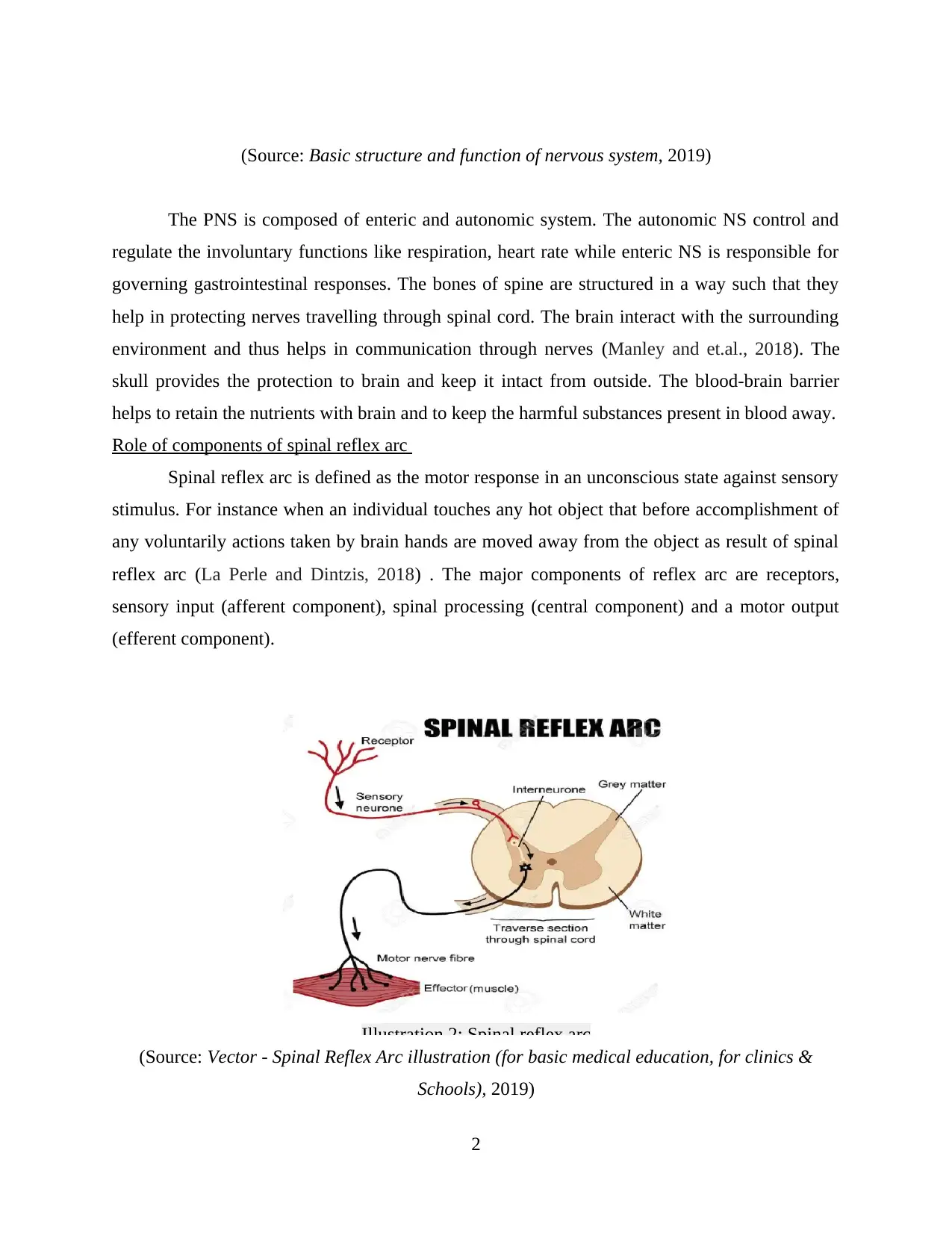
(Source: Basic structure and function of nervous system, 2019)
The PNS is composed of enteric and autonomic system. The autonomic NS control and
regulate the involuntary functions like respiration, heart rate while enteric NS is responsible for
governing gastrointestinal responses. The bones of spine are structured in a way such that they
help in protecting nerves travelling through spinal cord. The brain interact with the surrounding
environment and thus helps in communication through nerves (Manley and et.al., 2018). The
skull provides the protection to brain and keep it intact from outside. The blood-brain barrier
helps to retain the nutrients with brain and to keep the harmful substances present in blood away.
Role of components of spinal reflex arc
Spinal reflex arc is defined as the motor response in an unconscious state against sensory
stimulus. For instance when an individual touches any hot object that before accomplishment of
any voluntarily actions taken by brain hands are moved away from the object as result of spinal
reflex arc (La Perle and Dintzis, 2018) . The major components of reflex arc are receptors,
sensory input (afferent component), spinal processing (central component) and a motor output
(efferent component).
(Source: Vector - Spinal Reflex Arc illustration (for basic medical education, for clinics &
Schools), 2019)
2
Illustration 2: Spinal reflex arc
The PNS is composed of enteric and autonomic system. The autonomic NS control and
regulate the involuntary functions like respiration, heart rate while enteric NS is responsible for
governing gastrointestinal responses. The bones of spine are structured in a way such that they
help in protecting nerves travelling through spinal cord. The brain interact with the surrounding
environment and thus helps in communication through nerves (Manley and et.al., 2018). The
skull provides the protection to brain and keep it intact from outside. The blood-brain barrier
helps to retain the nutrients with brain and to keep the harmful substances present in blood away.
Role of components of spinal reflex arc
Spinal reflex arc is defined as the motor response in an unconscious state against sensory
stimulus. For instance when an individual touches any hot object that before accomplishment of
any voluntarily actions taken by brain hands are moved away from the object as result of spinal
reflex arc (La Perle and Dintzis, 2018) . The major components of reflex arc are receptors,
sensory input (afferent component), spinal processing (central component) and a motor output
(efferent component).
(Source: Vector - Spinal Reflex Arc illustration (for basic medical education, for clinics &
Schools), 2019)
2
Illustration 2: Spinal reflex arc
Secure Best Marks with AI Grader
Need help grading? Try our AI Grader for instant feedback on your assignments.
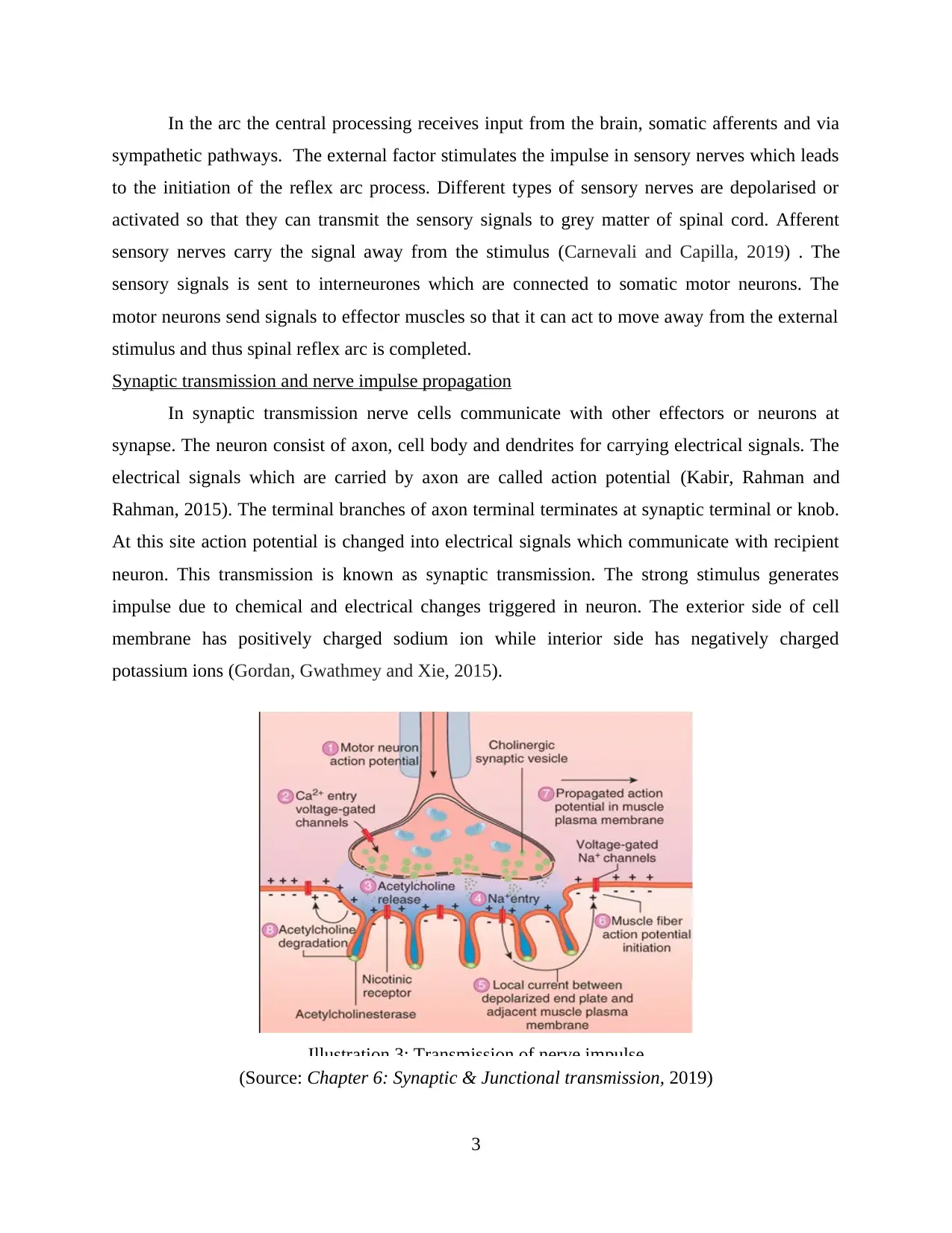
In the arc the central processing receives input from the brain, somatic afferents and via
sympathetic pathways. The external factor stimulates the impulse in sensory nerves which leads
to the initiation of the reflex arc process. Different types of sensory nerves are depolarised or
activated so that they can transmit the sensory signals to grey matter of spinal cord. Afferent
sensory nerves carry the signal away from the stimulus (Carnevali and Capilla, 2019) . The
sensory signals is sent to interneurones which are connected to somatic motor neurons. The
motor neurons send signals to effector muscles so that it can act to move away from the external
stimulus and thus spinal reflex arc is completed.
Synaptic transmission and nerve impulse propagation
In synaptic transmission nerve cells communicate with other effectors or neurons at
synapse. The neuron consist of axon, cell body and dendrites for carrying electrical signals. The
electrical signals which are carried by axon are called action potential (Kabir, Rahman and
Rahman, 2015). The terminal branches of axon terminal terminates at synaptic terminal or knob.
At this site action potential is changed into electrical signals which communicate with recipient
neuron. This transmission is known as synaptic transmission. The strong stimulus generates
impulse due to chemical and electrical changes triggered in neuron. The exterior side of cell
membrane has positively charged sodium ion while interior side has negatively charged
potassium ions (Gordan, Gwathmey and Xie, 2015).
(Source: Chapter 6: Synaptic & Junctional transmission, 2019)
3
Illustration 3: Transmission of nerve impulse
sympathetic pathways. The external factor stimulates the impulse in sensory nerves which leads
to the initiation of the reflex arc process. Different types of sensory nerves are depolarised or
activated so that they can transmit the sensory signals to grey matter of spinal cord. Afferent
sensory nerves carry the signal away from the stimulus (Carnevali and Capilla, 2019) . The
sensory signals is sent to interneurones which are connected to somatic motor neurons. The
motor neurons send signals to effector muscles so that it can act to move away from the external
stimulus and thus spinal reflex arc is completed.
Synaptic transmission and nerve impulse propagation
In synaptic transmission nerve cells communicate with other effectors or neurons at
synapse. The neuron consist of axon, cell body and dendrites for carrying electrical signals. The
electrical signals which are carried by axon are called action potential (Kabir, Rahman and
Rahman, 2015). The terminal branches of axon terminal terminates at synaptic terminal or knob.
At this site action potential is changed into electrical signals which communicate with recipient
neuron. This transmission is known as synaptic transmission. The strong stimulus generates
impulse due to chemical and electrical changes triggered in neuron. The exterior side of cell
membrane has positively charged sodium ion while interior side has negatively charged
potassium ions (Gordan, Gwathmey and Xie, 2015).
(Source: Chapter 6: Synaptic & Junctional transmission, 2019)
3
Illustration 3: Transmission of nerve impulse
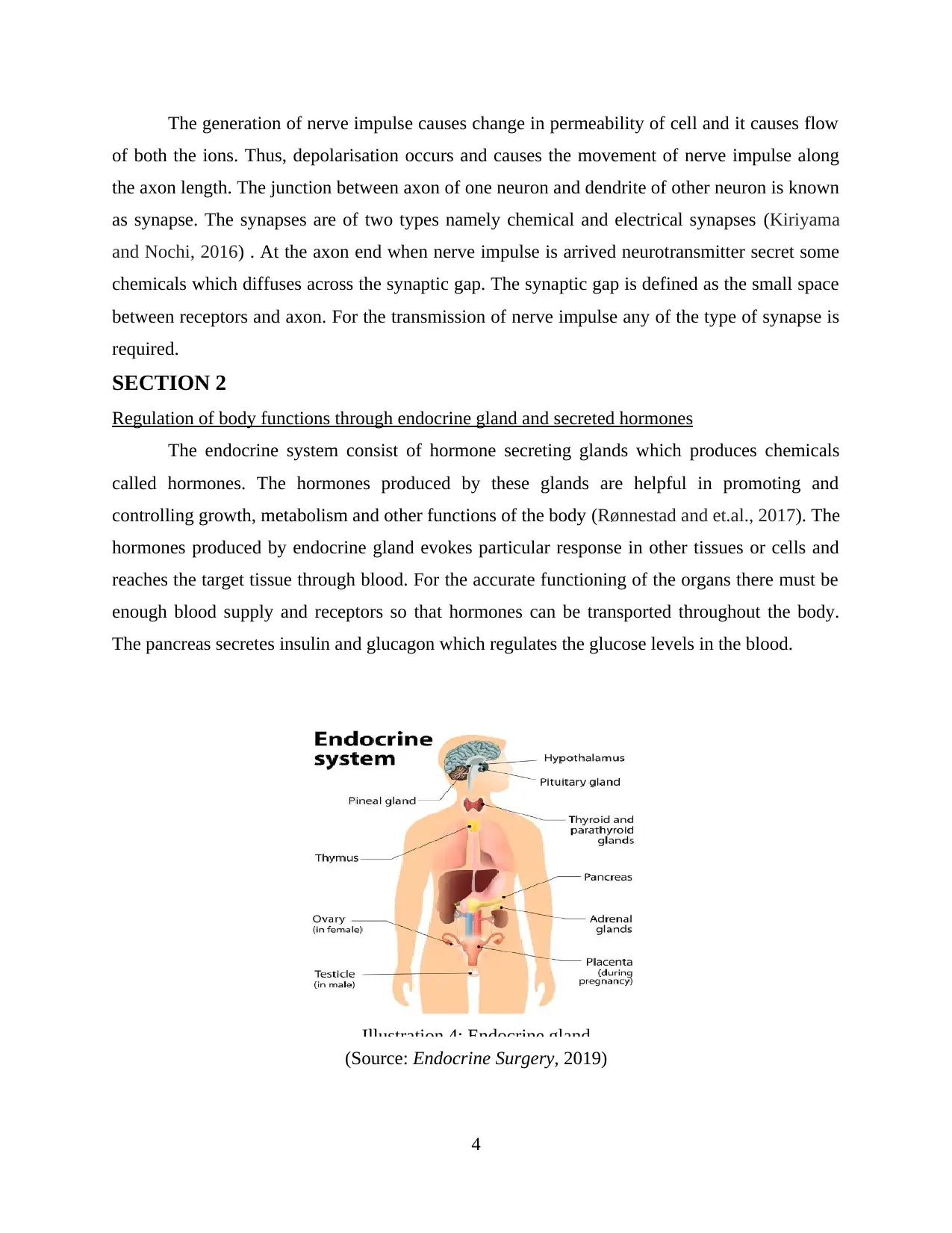
The generation of nerve impulse causes change in permeability of cell and it causes flow
of both the ions. Thus, depolarisation occurs and causes the movement of nerve impulse along
the axon length. The junction between axon of one neuron and dendrite of other neuron is known
as synapse. The synapses are of two types namely chemical and electrical synapses (Kiriyama
and Nochi, 2016) . At the axon end when nerve impulse is arrived neurotransmitter secret some
chemicals which diffuses across the synaptic gap. The synaptic gap is defined as the small space
between receptors and axon. For the transmission of nerve impulse any of the type of synapse is
required.
SECTION 2
Regulation of body functions through endocrine gland and secreted hormones
The endocrine system consist of hormone secreting glands which produces chemicals
called hormones. The hormones produced by these glands are helpful in promoting and
controlling growth, metabolism and other functions of the body (Rønnestad and et.al., 2017). The
hormones produced by endocrine gland evokes particular response in other tissues or cells and
reaches the target tissue through blood. For the accurate functioning of the organs there must be
enough blood supply and receptors so that hormones can be transported throughout the body.
The pancreas secretes insulin and glucagon which regulates the glucose levels in the blood.
(Source: Endocrine Surgery, 2019)
4
Illustration 4: Endocrine gland
of both the ions. Thus, depolarisation occurs and causes the movement of nerve impulse along
the axon length. The junction between axon of one neuron and dendrite of other neuron is known
as synapse. The synapses are of two types namely chemical and electrical synapses (Kiriyama
and Nochi, 2016) . At the axon end when nerve impulse is arrived neurotransmitter secret some
chemicals which diffuses across the synaptic gap. The synaptic gap is defined as the small space
between receptors and axon. For the transmission of nerve impulse any of the type of synapse is
required.
SECTION 2
Regulation of body functions through endocrine gland and secreted hormones
The endocrine system consist of hormone secreting glands which produces chemicals
called hormones. The hormones produced by these glands are helpful in promoting and
controlling growth, metabolism and other functions of the body (Rønnestad and et.al., 2017). The
hormones produced by endocrine gland evokes particular response in other tissues or cells and
reaches the target tissue through blood. For the accurate functioning of the organs there must be
enough blood supply and receptors so that hormones can be transported throughout the body.
The pancreas secretes insulin and glucagon which regulates the glucose levels in the blood.
(Source: Endocrine Surgery, 2019)
4
Illustration 4: Endocrine gland
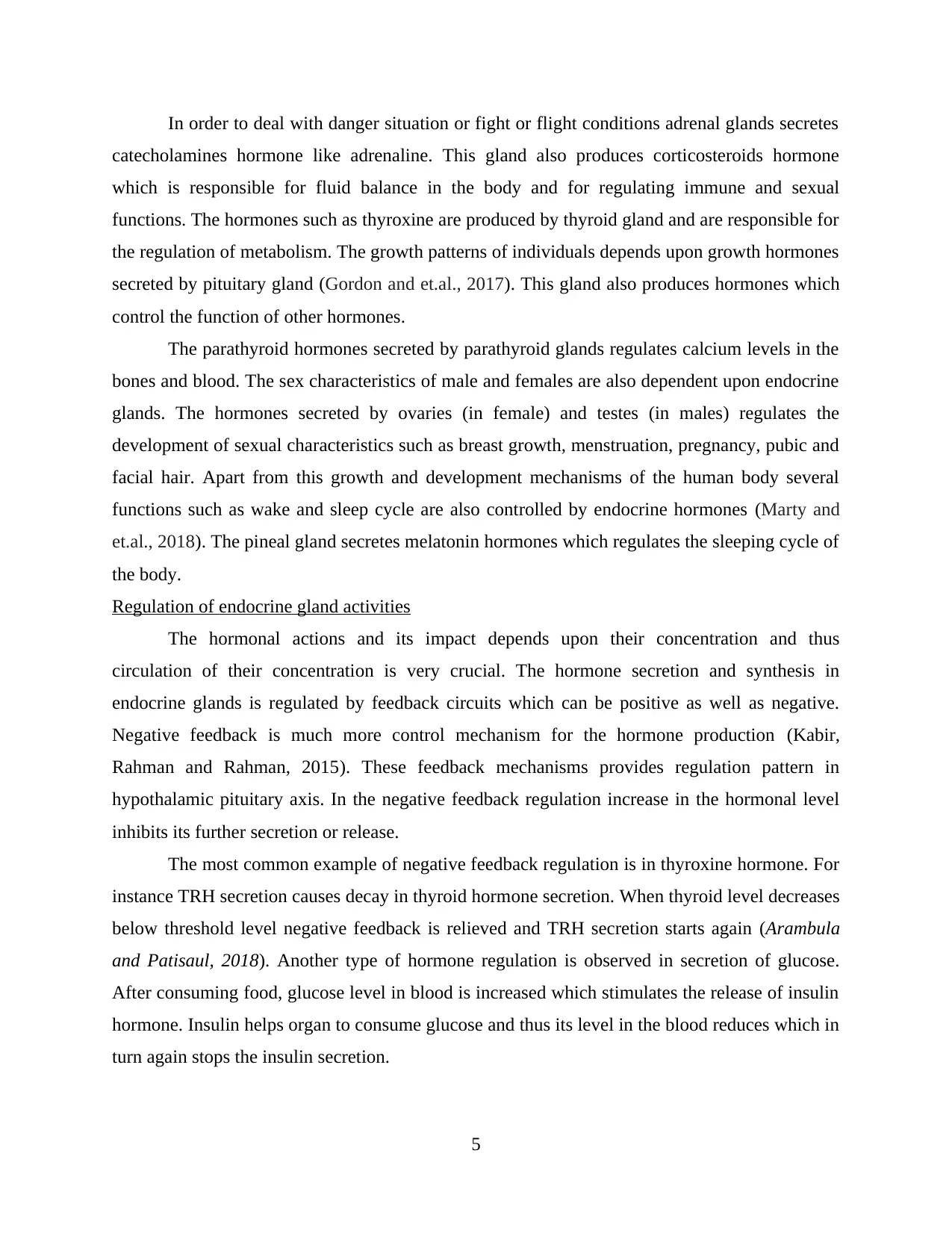
In order to deal with danger situation or fight or flight conditions adrenal glands secretes
catecholamines hormone like adrenaline. This gland also produces corticosteroids hormone
which is responsible for fluid balance in the body and for regulating immune and sexual
functions. The hormones such as thyroxine are produced by thyroid gland and are responsible for
the regulation of metabolism. The growth patterns of individuals depends upon growth hormones
secreted by pituitary gland (Gordon and et.al., 2017). This gland also produces hormones which
control the function of other hormones.
The parathyroid hormones secreted by parathyroid glands regulates calcium levels in the
bones and blood. The sex characteristics of male and females are also dependent upon endocrine
glands. The hormones secreted by ovaries (in female) and testes (in males) regulates the
development of sexual characteristics such as breast growth, menstruation, pregnancy, pubic and
facial hair. Apart from this growth and development mechanisms of the human body several
functions such as wake and sleep cycle are also controlled by endocrine hormones (Marty and
et.al., 2018). The pineal gland secretes melatonin hormones which regulates the sleeping cycle of
the body.
Regulation of endocrine gland activities
The hormonal actions and its impact depends upon their concentration and thus
circulation of their concentration is very crucial. The hormone secretion and synthesis in
endocrine glands is regulated by feedback circuits which can be positive as well as negative.
Negative feedback is much more control mechanism for the hormone production (Kabir,
Rahman and Rahman, 2015). These feedback mechanisms provides regulation pattern in
hypothalamic pituitary axis. In the negative feedback regulation increase in the hormonal level
inhibits its further secretion or release.
The most common example of negative feedback regulation is in thyroxine hormone. For
instance TRH secretion causes decay in thyroid hormone secretion. When thyroid level decreases
below threshold level negative feedback is relieved and TRH secretion starts again (Arambula
and Patisaul, 2018). Another type of hormone regulation is observed in secretion of glucose.
After consuming food, glucose level in blood is increased which stimulates the release of insulin
hormone. Insulin helps organ to consume glucose and thus its level in the blood reduces which in
turn again stops the insulin secretion.
5
catecholamines hormone like adrenaline. This gland also produces corticosteroids hormone
which is responsible for fluid balance in the body and for regulating immune and sexual
functions. The hormones such as thyroxine are produced by thyroid gland and are responsible for
the regulation of metabolism. The growth patterns of individuals depends upon growth hormones
secreted by pituitary gland (Gordon and et.al., 2017). This gland also produces hormones which
control the function of other hormones.
The parathyroid hormones secreted by parathyroid glands regulates calcium levels in the
bones and blood. The sex characteristics of male and females are also dependent upon endocrine
glands. The hormones secreted by ovaries (in female) and testes (in males) regulates the
development of sexual characteristics such as breast growth, menstruation, pregnancy, pubic and
facial hair. Apart from this growth and development mechanisms of the human body several
functions such as wake and sleep cycle are also controlled by endocrine hormones (Marty and
et.al., 2018). The pineal gland secretes melatonin hormones which regulates the sleeping cycle of
the body.
Regulation of endocrine gland activities
The hormonal actions and its impact depends upon their concentration and thus
circulation of their concentration is very crucial. The hormone secretion and synthesis in
endocrine glands is regulated by feedback circuits which can be positive as well as negative.
Negative feedback is much more control mechanism for the hormone production (Kabir,
Rahman and Rahman, 2015). These feedback mechanisms provides regulation pattern in
hypothalamic pituitary axis. In the negative feedback regulation increase in the hormonal level
inhibits its further secretion or release.
The most common example of negative feedback regulation is in thyroxine hormone. For
instance TRH secretion causes decay in thyroid hormone secretion. When thyroid level decreases
below threshold level negative feedback is relieved and TRH secretion starts again (Arambula
and Patisaul, 2018). Another type of hormone regulation is observed in secretion of glucose.
After consuming food, glucose level in blood is increased which stimulates the release of insulin
hormone. Insulin helps organ to consume glucose and thus its level in the blood reduces which in
turn again stops the insulin secretion.
5
Paraphrase This Document
Need a fresh take? Get an instant paraphrase of this document with our AI Paraphraser
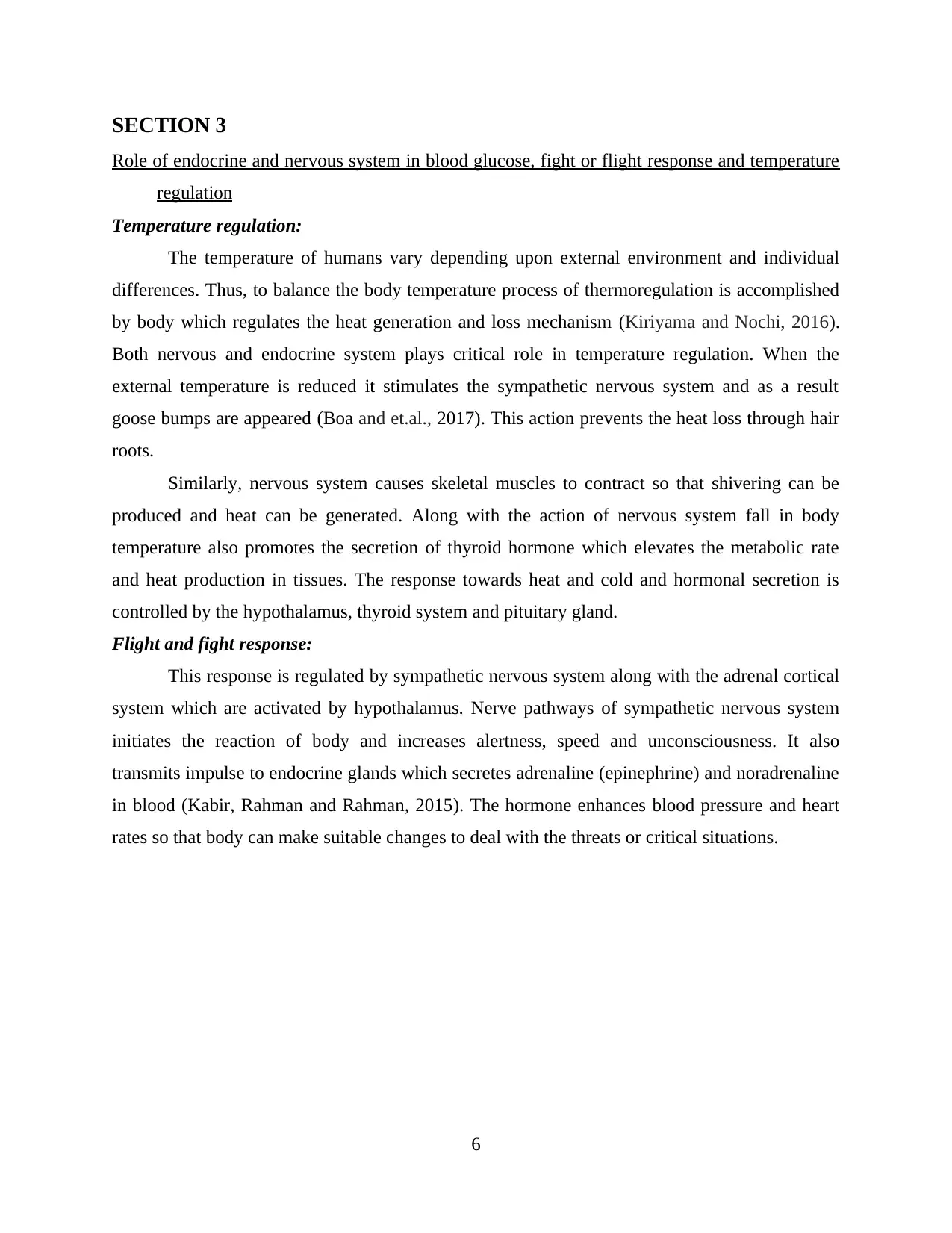
SECTION 3
Role of endocrine and nervous system in blood glucose, fight or flight response and temperature
regulation
Temperature regulation:
The temperature of humans vary depending upon external environment and individual
differences. Thus, to balance the body temperature process of thermoregulation is accomplished
by body which regulates the heat generation and loss mechanism (Kiriyama and Nochi, 2016).
Both nervous and endocrine system plays critical role in temperature regulation. When the
external temperature is reduced it stimulates the sympathetic nervous system and as a result
goose bumps are appeared (Boa and et.al., 2017). This action prevents the heat loss through hair
roots.
Similarly, nervous system causes skeletal muscles to contract so that shivering can be
produced and heat can be generated. Along with the action of nervous system fall in body
temperature also promotes the secretion of thyroid hormone which elevates the metabolic rate
and heat production in tissues. The response towards heat and cold and hormonal secretion is
controlled by the hypothalamus, thyroid system and pituitary gland.
Flight and fight response:
This response is regulated by sympathetic nervous system along with the adrenal cortical
system which are activated by hypothalamus. Nerve pathways of sympathetic nervous system
initiates the reaction of body and increases alertness, speed and unconsciousness. It also
transmits impulse to endocrine glands which secretes adrenaline (epinephrine) and noradrenaline
in blood (Kabir, Rahman and Rahman, 2015). The hormone enhances blood pressure and heart
rates so that body can make suitable changes to deal with the threats or critical situations.
6
Role of endocrine and nervous system in blood glucose, fight or flight response and temperature
regulation
Temperature regulation:
The temperature of humans vary depending upon external environment and individual
differences. Thus, to balance the body temperature process of thermoregulation is accomplished
by body which regulates the heat generation and loss mechanism (Kiriyama and Nochi, 2016).
Both nervous and endocrine system plays critical role in temperature regulation. When the
external temperature is reduced it stimulates the sympathetic nervous system and as a result
goose bumps are appeared (Boa and et.al., 2017). This action prevents the heat loss through hair
roots.
Similarly, nervous system causes skeletal muscles to contract so that shivering can be
produced and heat can be generated. Along with the action of nervous system fall in body
temperature also promotes the secretion of thyroid hormone which elevates the metabolic rate
and heat production in tissues. The response towards heat and cold and hormonal secretion is
controlled by the hypothalamus, thyroid system and pituitary gland.
Flight and fight response:
This response is regulated by sympathetic nervous system along with the adrenal cortical
system which are activated by hypothalamus. Nerve pathways of sympathetic nervous system
initiates the reaction of body and increases alertness, speed and unconsciousness. It also
transmits impulse to endocrine glands which secretes adrenaline (epinephrine) and noradrenaline
in blood (Kabir, Rahman and Rahman, 2015). The hormone enhances blood pressure and heart
rates so that body can make suitable changes to deal with the threats or critical situations.
6
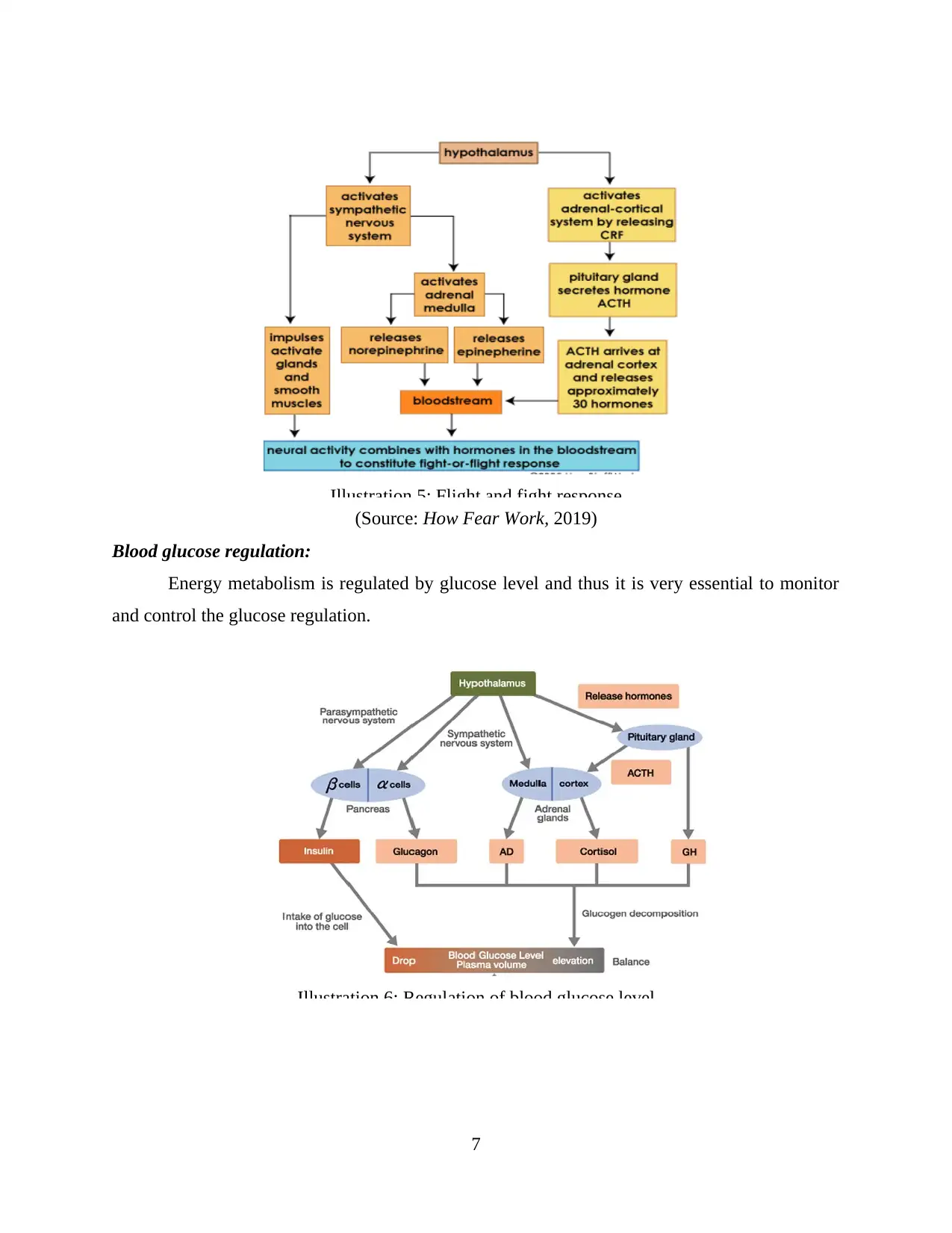
(Source: How Fear Work, 2019)
Blood glucose regulation:
Energy metabolism is regulated by glucose level and thus it is very essential to monitor
and control the glucose regulation.
7
Illustration 5: Flight and fight response
Illustration 6: Regulation of blood glucose level
Blood glucose regulation:
Energy metabolism is regulated by glucose level and thus it is very essential to monitor
and control the glucose regulation.
7
Illustration 5: Flight and fight response
Illustration 6: Regulation of blood glucose level
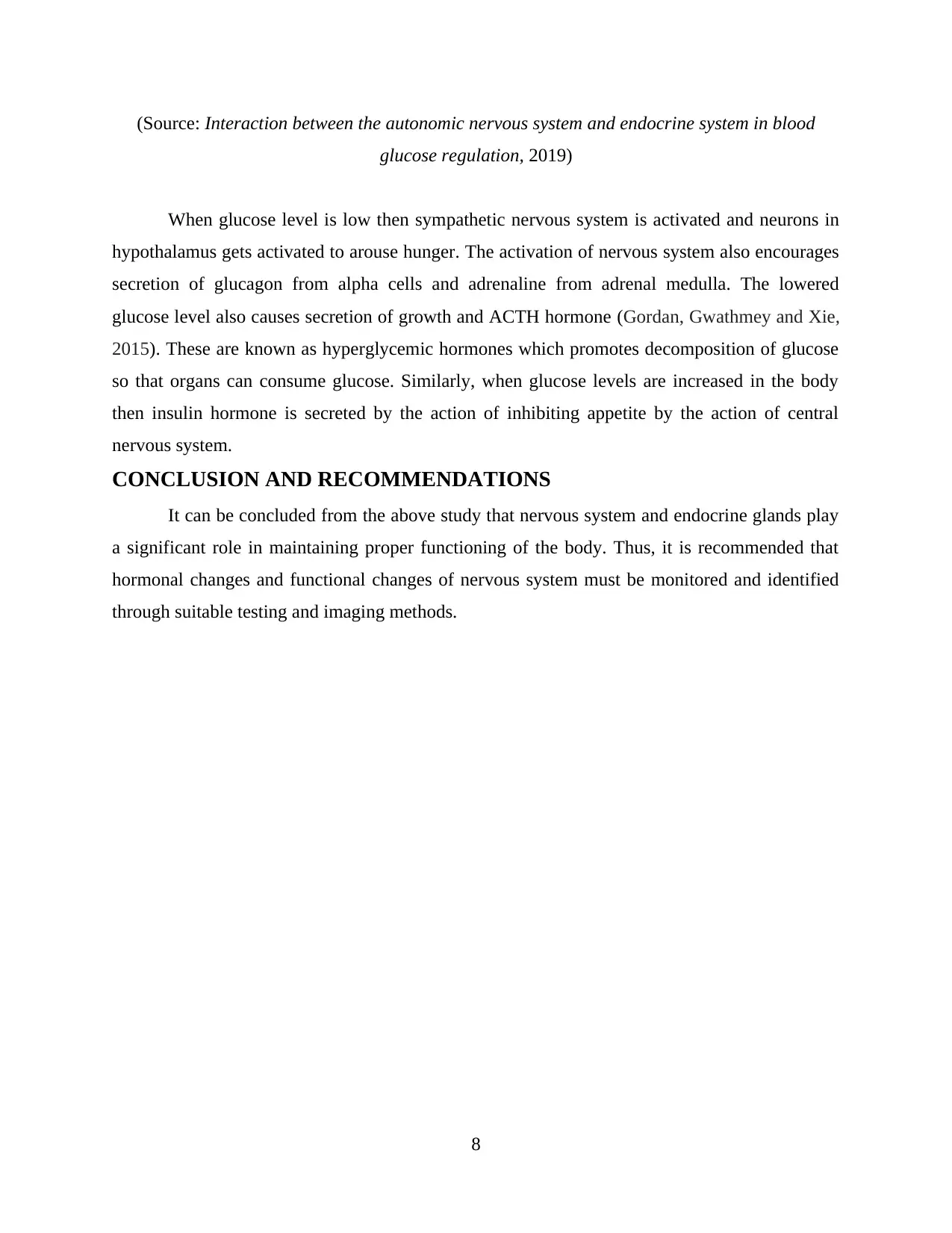
(Source: Interaction between the autonomic nervous system and endocrine system in blood
glucose regulation, 2019)
When glucose level is low then sympathetic nervous system is activated and neurons in
hypothalamus gets activated to arouse hunger. The activation of nervous system also encourages
secretion of glucagon from alpha cells and adrenaline from adrenal medulla. The lowered
glucose level also causes secretion of growth and ACTH hormone (Gordan, Gwathmey and Xie,
2015). These are known as hyperglycemic hormones which promotes decomposition of glucose
so that organs can consume glucose. Similarly, when glucose levels are increased in the body
then insulin hormone is secreted by the action of inhibiting appetite by the action of central
nervous system.
CONCLUSION AND RECOMMENDATIONS
It can be concluded from the above study that nervous system and endocrine glands play
a significant role in maintaining proper functioning of the body. Thus, it is recommended that
hormonal changes and functional changes of nervous system must be monitored and identified
through suitable testing and imaging methods.
8
glucose regulation, 2019)
When glucose level is low then sympathetic nervous system is activated and neurons in
hypothalamus gets activated to arouse hunger. The activation of nervous system also encourages
secretion of glucagon from alpha cells and adrenaline from adrenal medulla. The lowered
glucose level also causes secretion of growth and ACTH hormone (Gordan, Gwathmey and Xie,
2015). These are known as hyperglycemic hormones which promotes decomposition of glucose
so that organs can consume glucose. Similarly, when glucose levels are increased in the body
then insulin hormone is secreted by the action of inhibiting appetite by the action of central
nervous system.
CONCLUSION AND RECOMMENDATIONS
It can be concluded from the above study that nervous system and endocrine glands play
a significant role in maintaining proper functioning of the body. Thus, it is recommended that
hormonal changes and functional changes of nervous system must be monitored and identified
through suitable testing and imaging methods.
8
Secure Best Marks with AI Grader
Need help grading? Try our AI Grader for instant feedback on your assignments.
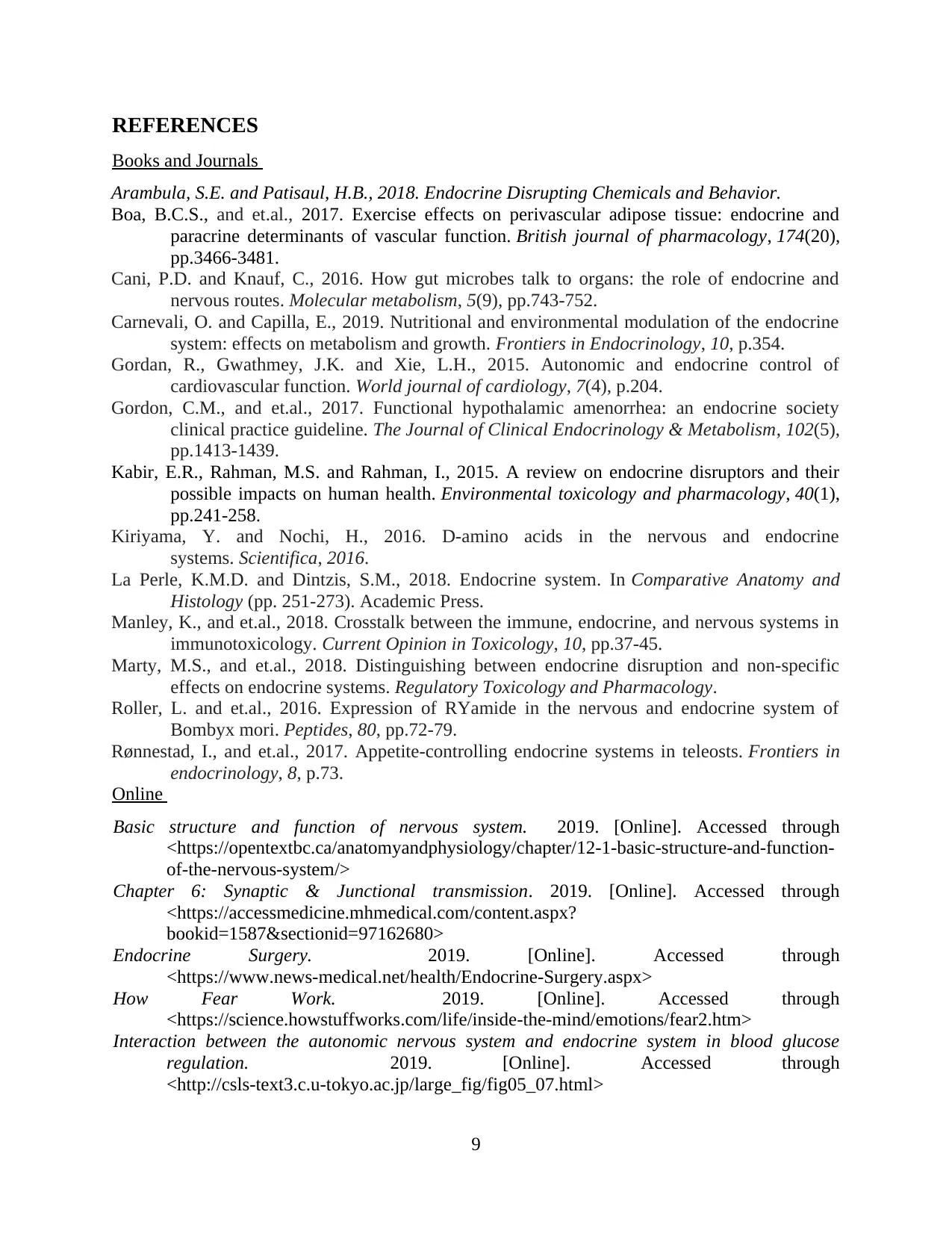
REFERENCES
Books and Journals
Arambula, S.E. and Patisaul, H.B., 2018. Endocrine Disrupting Chemicals and Behavior.
Boa, B.C.S., and et.al., 2017. Exercise effects on perivascular adipose tissue: endocrine and
paracrine determinants of vascular function. British journal of pharmacology, 174(20),
pp.3466-3481.
Cani, P.D. and Knauf, C., 2016. How gut microbes talk to organs: the role of endocrine and
nervous routes. Molecular metabolism, 5(9), pp.743-752.
Carnevali, O. and Capilla, E., 2019. Nutritional and environmental modulation of the endocrine
system: effects on metabolism and growth. Frontiers in Endocrinology, 10, p.354.
Gordan, R., Gwathmey, J.K. and Xie, L.H., 2015. Autonomic and endocrine control of
cardiovascular function. World journal of cardiology, 7(4), p.204.
Gordon, C.M., and et.al., 2017. Functional hypothalamic amenorrhea: an endocrine society
clinical practice guideline. The Journal of Clinical Endocrinology & Metabolism, 102(5),
pp.1413-1439.
Kabir, E.R., Rahman, M.S. and Rahman, I., 2015. A review on endocrine disruptors and their
possible impacts on human health. Environmental toxicology and pharmacology, 40(1),
pp.241-258.
Kiriyama, Y. and Nochi, H., 2016. D-amino acids in the nervous and endocrine
systems. Scientifica, 2016.
La Perle, K.M.D. and Dintzis, S.M., 2018. Endocrine system. In Comparative Anatomy and
Histology (pp. 251-273). Academic Press.
Manley, K., and et.al., 2018. Crosstalk between the immune, endocrine, and nervous systems in
immunotoxicology. Current Opinion in Toxicology, 10, pp.37-45.
Marty, M.S., and et.al., 2018. Distinguishing between endocrine disruption and non-specific
effects on endocrine systems. Regulatory Toxicology and Pharmacology.
Roller, L. and et.al., 2016. Expression of RYamide in the nervous and endocrine system of
Bombyx mori. Peptides, 80, pp.72-79.
Rønnestad, I., and et.al., 2017. Appetite-controlling endocrine systems in teleosts. Frontiers in
endocrinology, 8, p.73.
Online
Basic structure and function of nervous system. 2019. [Online]. Accessed through
<https://opentextbc.ca/anatomyandphysiology/chapter/12-1-basic-structure-and-function-
of-the-nervous-system/>
Chapter 6: Synaptic & Junctional transmission. 2019. [Online]. Accessed through
<https://accessmedicine.mhmedical.com/content.aspx?
bookid=1587§ionid=97162680>
Endocrine Surgery. 2019. [Online]. Accessed through
<https://www.news-medical.net/health/Endocrine-Surgery.aspx>
How Fear Work. 2019. [Online]. Accessed through
<https://science.howstuffworks.com/life/inside-the-mind/emotions/fear2.htm>
Interaction between the autonomic nervous system and endocrine system in blood glucose
regulation. 2019. [Online]. Accessed through
<http://csls-text3.c.u-tokyo.ac.jp/large_fig/fig05_07.html>
9
Books and Journals
Arambula, S.E. and Patisaul, H.B., 2018. Endocrine Disrupting Chemicals and Behavior.
Boa, B.C.S., and et.al., 2017. Exercise effects on perivascular adipose tissue: endocrine and
paracrine determinants of vascular function. British journal of pharmacology, 174(20),
pp.3466-3481.
Cani, P.D. and Knauf, C., 2016. How gut microbes talk to organs: the role of endocrine and
nervous routes. Molecular metabolism, 5(9), pp.743-752.
Carnevali, O. and Capilla, E., 2019. Nutritional and environmental modulation of the endocrine
system: effects on metabolism and growth. Frontiers in Endocrinology, 10, p.354.
Gordan, R., Gwathmey, J.K. and Xie, L.H., 2015. Autonomic and endocrine control of
cardiovascular function. World journal of cardiology, 7(4), p.204.
Gordon, C.M., and et.al., 2017. Functional hypothalamic amenorrhea: an endocrine society
clinical practice guideline. The Journal of Clinical Endocrinology & Metabolism, 102(5),
pp.1413-1439.
Kabir, E.R., Rahman, M.S. and Rahman, I., 2015. A review on endocrine disruptors and their
possible impacts on human health. Environmental toxicology and pharmacology, 40(1),
pp.241-258.
Kiriyama, Y. and Nochi, H., 2016. D-amino acids in the nervous and endocrine
systems. Scientifica, 2016.
La Perle, K.M.D. and Dintzis, S.M., 2018. Endocrine system. In Comparative Anatomy and
Histology (pp. 251-273). Academic Press.
Manley, K., and et.al., 2018. Crosstalk between the immune, endocrine, and nervous systems in
immunotoxicology. Current Opinion in Toxicology, 10, pp.37-45.
Marty, M.S., and et.al., 2018. Distinguishing between endocrine disruption and non-specific
effects on endocrine systems. Regulatory Toxicology and Pharmacology.
Roller, L. and et.al., 2016. Expression of RYamide in the nervous and endocrine system of
Bombyx mori. Peptides, 80, pp.72-79.
Rønnestad, I., and et.al., 2017. Appetite-controlling endocrine systems in teleosts. Frontiers in
endocrinology, 8, p.73.
Online
Basic structure and function of nervous system. 2019. [Online]. Accessed through
<https://opentextbc.ca/anatomyandphysiology/chapter/12-1-basic-structure-and-function-
of-the-nervous-system/>
Chapter 6: Synaptic & Junctional transmission. 2019. [Online]. Accessed through
<https://accessmedicine.mhmedical.com/content.aspx?
bookid=1587§ionid=97162680>
Endocrine Surgery. 2019. [Online]. Accessed through
<https://www.news-medical.net/health/Endocrine-Surgery.aspx>
How Fear Work. 2019. [Online]. Accessed through
<https://science.howstuffworks.com/life/inside-the-mind/emotions/fear2.htm>
Interaction between the autonomic nervous system and endocrine system in blood glucose
regulation. 2019. [Online]. Accessed through
<http://csls-text3.c.u-tokyo.ac.jp/large_fig/fig05_07.html>
9

Vector - Spinal Reflex Arc illustration (for basic medical education, for clinics & Schools). 2019.
[Online]. Accessed through <https://www.123rf.com/photo_19423972_spinal-reflex-arc-
illustration-for-basic-medical-education-for-clinics-schools-.html>
10
[Online]. Accessed through <https://www.123rf.com/photo_19423972_spinal-reflex-arc-
illustration-for-basic-medical-education-for-clinics-schools-.html>
10

11
Paraphrase This Document
Need a fresh take? Get an instant paraphrase of this document with our AI Paraphraser

12

13

14
1 out of 16
Related Documents
Your All-in-One AI-Powered Toolkit for Academic Success.
+13062052269
info@desklib.com
Available 24*7 on WhatsApp / Email
![[object Object]](/_next/static/media/star-bottom.7253800d.svg)
Unlock your academic potential
© 2024 | Zucol Services PVT LTD | All rights reserved.





